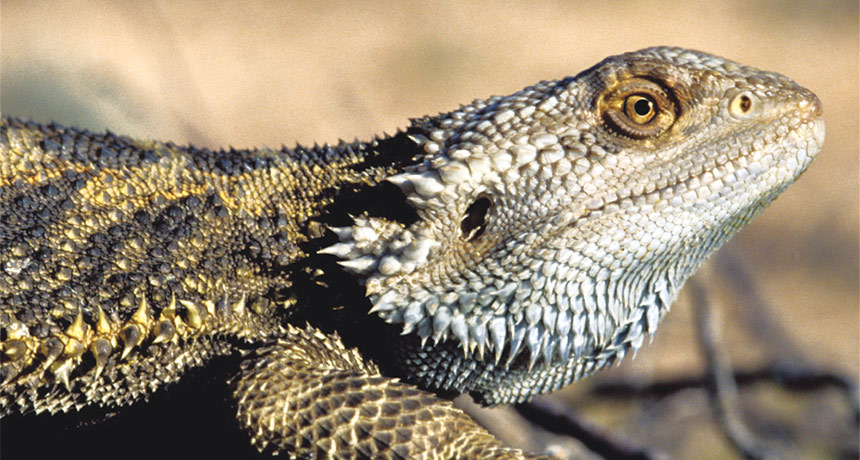
WHEN DRAGONS OVERHEAT Australian bearded dragons are the first reptiles discovered to change sex in the wild due to overheating, raising questions about how they will cope with climate change.
Arthur Georges/University of Canberra
Some genetically male Australian bearded dragons are growing up as fully functional females in the wild — the first reptiles confirmed to reverse sex under natural conditions.
Eleven of 131 Pogona vitticeps lizards caught at several sites in southeastern Australia during three years had female sex organs but the male ZZ set of sex chromosomes, says Clare Holleley of the University of Canberra in Australia. This survey of wild dragons shows that sex reversal in reptiles isn’t just a laboratory curiosity, Holleley and colleagues report in the July 2 Nature.
Earlier research had shown that genetics dominates in determining sex in the dragons during development at temperatures below 32°Celsius. When eggs develop at higher temperatures, though, environment overrides genetics in some of the males and directs them to grow female bodies.
After discovering the feminized males, researchers paired four of the wild sex-change lizards and two lab-bred ones with normal genetic ZZ male dragons. These lizards not only mated successfully but also produced 47 eggs per year on average, about twice the normal number of eggs, Holleley says.
With no genetic female moms to pass along the feminizing W chromosome, the next generation inherited only ZZ sex chromosomes. If overheating wild dragons follow this scenario, the W in a population could dwindle fast. And the possibility for genetic sex determination could disappear with it, creating a population that relies on temperature to determine which eggs grow up male or female.
Biologists have already recognized that control of sex determination has switched back and forth between genetics and the environment over the course of evolution in lizard species.
The temperature override in wild bearded dragons could be “the tip of a very large iceberg,” says Rick Shine of the University of Sydney. He discovered the first known case, in Bassiana skinks, of a temperature override for genetic sex determination in reptiles. (Chills during incubation turn genetic females into males.) People often talk about sex determination as either genetic or environmental, Shine laments. “But Mother Nature is a complicated lady, and multifactorial systems are probably far more common than we currently realize.”
“Reptiles determine sex any which way you could possibly imagine,” Holleley says. Just among species with genetically controlled sexes, some produce males when their two sex chromosomes differ from each other. Other species, such as the bearded dragon, produce females when there’s a mismatch.
What overheating means for wild lizards as the climate warms remains to be seen, says Nicola Mitchell of the University of Western Australia. “There is no definitive answer yet as to whether a switch to temperature sex determination makes a species more or less vulnerable to global warming,” Mitchell says. Many ancient reptile lineages, such as sea turtles and the tuatara she studies, determine sex by temperature, “yet have persisted throughout eons of environmental change.” So she wants to know whether the bearded dragons have any capacity to adapt as the temperature warms.
That, Holleley says, is the next big question.





